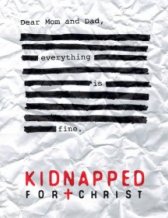11.05.15
In Kate Logan’s directorial debut, we follow her to the Dominican Republic where as a missionary she hopes to document the day-to-day happenings at a Christian reform school. A self-confessed Christian, we at first see Kate Logan travel to the Escuela Caribe in order to detail the positive effects it has on the children sent to it, yet through this, we are witness to a far sinister scheme, where teenagers are seemingly kept against there will and subjected to gruelling chores in the name of God.
As Logan’s very own faith begins to be tested due to the revelations she discovers, issues of religion are evidently at the forefront of the documentary, yet it also raises far wider questions about American society in general. Sent to what is essentially a behavioural modification centre, a majority of the teens have been sent because of their sexual orientation, highlighting how America still suffers from its archaic feelings towards those of a sexual disposition other than straight. Furthermore, Kidnapped for Christ also throws its weight behind the continuous debate on the contemporary uses of religion, and in Kidnapped, it doesn’t reflect well. Understandably, Logan’s documentary suffers from some elements of censorship, thus a definitive account of what takes place at every level of the centre is never truly revealed, but because of this, it only strengthens how perverse the Escuela Caribe school appears to be.
It is often said that there are six types of documentary; poetic, expository, observational, participatory, reflexive and performative, in which documentaries usually follow one of these throughout its entirety, yet Kidnapped differs. As Logan begins to realise the severity of the situation, we see the documentary shift between a number of the styles listed above, aiding Kidnapped for Christ with an intensity. As director, we see Kate Logan’s role within the documentary change drastically as what begins as an observational style of documentary suddenly switches to participatory as Logan see’s no choice but to help those who she has come to encounter.
Kidnapped for Christ makes for decidedly uncomfortable viewing, yet without this documentary it could be argued that centres such as the Escuela Caribe may have never been brought into the public domain; a frightening prospect.
As Logan’s very own faith begins to be tested due to the revelations she discovers, issues of religion are evidently at the forefront of the documentary, yet it also raises far wider questions about American society in general. Sent to what is essentially a behavioural modification centre, a majority of the teens have been sent because of their sexual orientation, highlighting how America still suffers from its archaic feelings towards those of a sexual disposition other than straight. Furthermore, Kidnapped for Christ also throws its weight behind the continuous debate on the contemporary uses of religion, and in Kidnapped, it doesn’t reflect well. Understandably, Logan’s documentary suffers from some elements of censorship, thus a definitive account of what takes place at every level of the centre is never truly revealed, but because of this, it only strengthens how perverse the Escuela Caribe school appears to be.
It is often said that there are six types of documentary; poetic, expository, observational, participatory, reflexive and performative, in which documentaries usually follow one of these throughout its entirety, yet Kidnapped differs. As Logan begins to realise the severity of the situation, we see the documentary shift between a number of the styles listed above, aiding Kidnapped for Christ with an intensity. As director, we see Kate Logan’s role within the documentary change drastically as what begins as an observational style of documentary suddenly switches to participatory as Logan see’s no choice but to help those who she has come to encounter.
Kidnapped for Christ makes for decidedly uncomfortable viewing, yet without this documentary it could be argued that centres such as the Escuela Caribe may have never been brought into the public domain; a frightening prospect.
